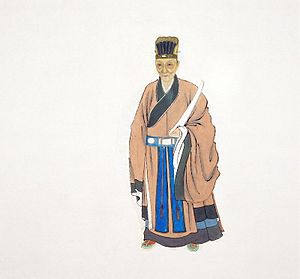Dong Qichang facts for kids
Dong Qichang (Chinese: 董其昌; pinyin: Dǒng Qíchāng; Wade–Giles: Tung Ch'i-ch'ang; courtesy name Xuanzai (玄宰); 1555–1636) was a famous Chinese painter, calligrapher, politician, and art expert. He lived during the later part of the Ming dynasty.
Contents
Dong Qichang's Life as a Scholar and Calligrapher
Dong Qichang was born in Hua Ting, which is now part of Shanghai. He was a very smart child. At just 12 years old, he passed an important local exam. This earned him a special spot at a government school.
He took the main imperial exam at 17. But he came in second place to his cousin because his handwriting, or calligraphy, wasn't very good. This made him work hard to improve it. He practiced until he became a well-known calligrapher. After that, he quickly moved up in the government. He passed the highest level of exams when he was 35. He eventually became an important official in the Ministry of Rites.
His time in government was sometimes difficult. In 1605, when he was giving an exam, students protested against him. This caused him to leave his job for a short time. He also had problems with some people, which led to an angry crowd burning down his house. Like many scholars, he also had tense relationships with the powerful eunuchs in the court. Later, during the Cultural Revolution, Dong's tomb in Songjiang District was damaged. His body, dressed in old Ming court clothes, was disrespected by people called Red Guards.
How Dong Qichang Painted
Dong Qichang's paintings focused more on showing feelings and ideas than on making things look exactly real. He didn't like art that seemed too smooth or overly emotional. Because of this, he often created landscapes where the spaces looked a bit twisted on purpose.
However, his art was not completely abstract. He still used ideas and styles from older artists, especially those from the Yuan dynasty. His ideas about expressing feelings in art were very important. They influenced later painters who were known for their unique, "individualist" styles.
Dong Qichang's Art Theories
In his writings about art, Dong Qichang came up with a big idea. He said that Chinese painting could be split into two main groups: the Northern School and the Southern School.
- The Northern School used fine lines and bright colors.
- The Southern School used quick, brush strokes, much like calligraphy.
These names can be confusing because they don't refer to actual places. Instead, they came from different ways of thinking in Chan Buddhism. So, a painter from the "Northern School" might live in the south, and a "Southern School" painter might live in the north. Dong Qichang strongly preferred the Southern School. He thought the Northern School was too simple or just for decoration.
His ideal for Southern School painting was for artists to create their own new style. They would do this by learning from and changing the styles of old masters. This idea was like the "sudden enlightenment" favored by Southern Chan Buddhism. He greatly admired famous painters like Mi Fu and Ni Zan.
Dong believed that by connecting with the styles of ancient masters, artists could find their own place in art history. They wouldn't just copy the past. Instead, they would build on it and even make it better. Dong's ideas were very important for artists and art collectors during the Qing dynasty. He, along with other art experts called the "Nine Friends," helped decide which painters were considered valuable. Experts say he was one of the first art historians to do more than just list artists. He also helped understand and group them.
Gallery
-
Dong Qichang, calligraphy of cursive and semi-cursive style, 1603. Tokyo National Museum.
-
Dong Qichang, The Qingbian Mountains in the Manner of Tung Yuan, dated 1617. Cleveland Museum of Art.
-
Dong Qichang, Landscapes in the Manner of Old Masters, dated 1621-24. Album of ten leaves, leaf two. Nelson-Atkins Museum of Art.
-
Seeking Ancient in Fengjing (葑泾访古图), ink on paper, height 80 cm, width 29.8 cm, National Palace Museum, Taipei.
-
Dong Qichang, Tree in Summer with the Shadow, National Palace Museum, Taipei.
See also
 In Spanish: Dong Qichang para niños
In Spanish: Dong Qichang para niños











